Themed collection Organocatalysis

Organocatalysis: a web collection
Showcasing a collection of cutting edge contributions by international leaders in the field of organocatalysis.

Chem. Commun., 2012,48, 10703-10703
https://doi.org/10.1039/C2CC90327J
Non-asymmetric organocatalysis
Organocatalytic reactions affording achiral compounds opened unexplored pathways in the synthesis of densely functionalized aromatic moieties, olefins and useful molecules such as natural substances.
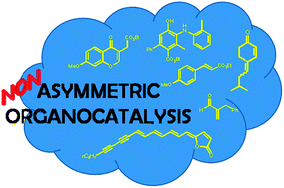
Chem. Commun., 2012,48, 6881-6896
https://doi.org/10.1039/C2CC31599H
Recent efforts directed to the development of more sustainable asymmetric organocatalysis
A critical discussion of recent strategies directed to the development of more sustainable asymmetric organocatalysis is presented.
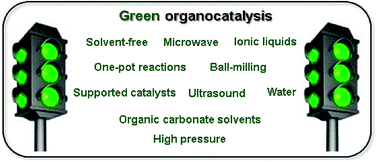
Chem. Commun., 2012,48, 5396-5409
https://doi.org/10.1039/C2CC30951C
Asymmetric organocascades involving the formation of two C–heteroatom bonds from two distinct heteroatoms
Enantioselective organocascades creating multiple carbon–heteroatom bonds are rare but these fascinating domino processes lead to highly functionalised optically active building blocks.
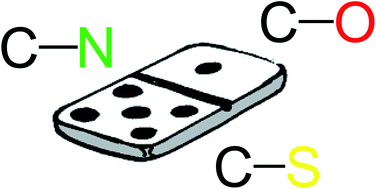
Org. Biomol. Chem., 2012,10, 3969-3973
https://doi.org/10.1039/C2OB25248A
Enantio- and periselective nitroalkene Diels–Alder reaction
It is successfully demonstrated that the nitroalkene Diels–Alder reaction can be rendered enantio- and periselective by helical–chiral hydrogen bond donor catalysts.

Org. Biomol. Chem., 2012,10, 9134-9136
https://doi.org/10.1039/C2OB26674A
Catalytic asymmetric Mannich-type reactions of α-cyano α-sulfonyl carbanions
An efficient asymmetric Mannich-type reaction of α-cyano α-sulfonyl carbanions has been achieved by exploiting the structural modularity and anion-recognition ability of chiral 1,2,3-triazolium ions. This protocol has proven to be applicable to a variety of N-Boc imines and cyanosulfones, affording β-amino α-cyanosulfones in excellent yields with high stereoselectivities.
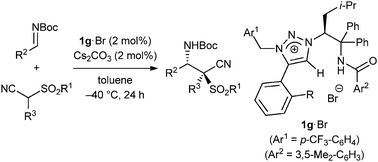
Chem. Commun., 2012,48, 7913-7915
https://doi.org/10.1039/C2CC32398B
Catalyst -controlled reversal of chemoselectivity in acylation of 2-aminopentane-1,5-diol derivatives
An organocatalyst enables chemoselective introduction of an acyl group onto the sterically hindered secondary hydroxy group in the presence of the primary one.
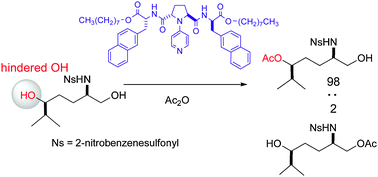
Chem. Commun., 2012,48, 6981-6983
https://doi.org/10.1039/C2CC32525J
Asymmetric Michael addition of boronic acids to a γ-hydroxy-α,β-unsaturated aldehyde catalyzed by resin-supported peptide
Resin-supported N-terminal prolyl peptide having suitable secondary structure effectively catalyzed asymmetric Michael addition of substituted β-styryl- and heteroarylboronates to 4-hydroxybut-2-enal.
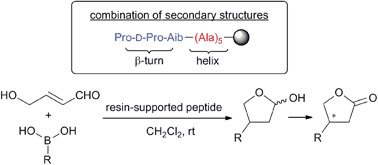
Org. Biomol. Chem., 2012,10, 4839-4843
https://doi.org/10.1039/C2OB25431J
Catalytic, enantio- and diastereoselective synthesis of γ-butyrolactones incorporating quaternary stereocentres
An organocatalyst promotes the enantio- and diastereoselective cycloaddition of aryl succinic anhydrides and aldehydes to generate paraconic acid (γ-butyrolactone) derivatives.
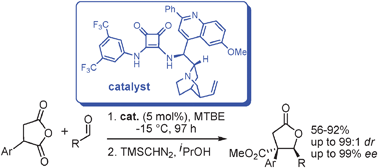
Chem. Commun., 2012,48, 6502-6504
https://doi.org/10.1039/C2CC32147E
Synthesis of symmetric anhydrides using visible light-mediated photoredox catalysis
A new approach to anhydride formation is reported via activation of C–O bonds by the Vilsmeier–Haack reagent formed by Ru(bpy)3Cl2 and CBr4 in DMF.
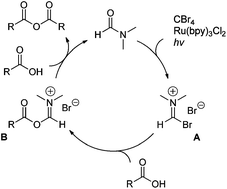
Org. Biomol. Chem., 2012,10, 4509-4511
https://doi.org/10.1039/C2OB25463H
Enantioselective bromolactonization of cis-1,2-disubstituted olefinic acids using an amino-thiocarbamate catalyst
A facile, highly regio- and enantioselective amino-thiocarbamate-catalyzed bromolactonization of cis-1,2-disubstituted olefinic acids has been developed.
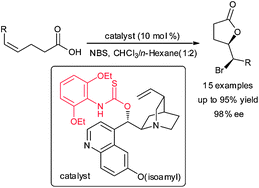
Chem. Commun., 2012,48, 5793-5795
https://doi.org/10.1039/C2CC31148H
Chiral proton catalysis of secondary nitroalkane additions to azomethine: synthesis of a potent GlyT1 inhibitor
Chiral proton catalysis enables an enantioselective synthesis of Lindsley's GlyT1 inhibitor and a general approach to aminomethyl azetidine pharmacophores.
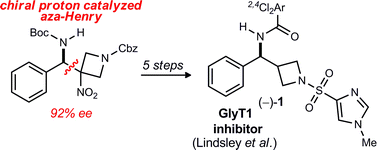
Chem. Commun., 2012,48, 5578-5580
https://doi.org/10.1039/C2CC32225K
Enantioselective synthesis of substituted pyrans via amine -catalyzed Michael addition and subsequent enolization/cyclisation
Organocatalytic construction of pyran derivatives via amine-catalyzed Michael addition and subsequent enolization/cyclisation has been described with high enantioselectivities.
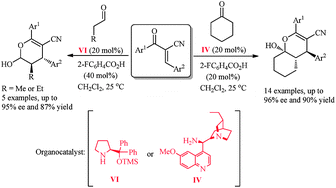
Chem. Commun., 2012,48, 5590-5592
https://doi.org/10.1039/C2CC31445B
Envisioning an enzymatic Diels–Alder reaction by in situ acid–base catalyzed diene generation
A novel and potentially efficient enzymatic Diels–Alder reaction, involving acid–base catalysis, is presented and evaluated.
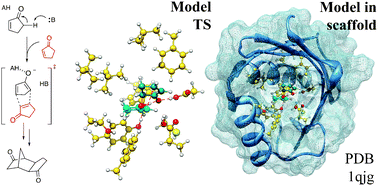
Chem. Commun., 2012,48, 5665-5667
https://doi.org/10.1039/C2CC31502E
Trichlorosilyl triflate-mediated enantioselective directed cross-aldol reaction between ketones using a chiral phosphine oxide as an organocatalyst
The first enantioselective directed cross-aldol reaction between simple ketones using trichlorosilyl triflate and a chiral phosphine oxide catalyst is described.
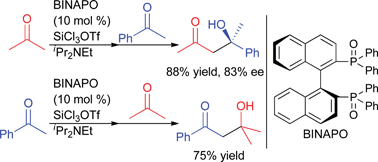
Chem. Commun., 2012,48, 5524-5526
https://doi.org/10.1039/C2CC31543B
Phosphine -catalyzed intramolecular γ-umpolung addition of α-aminoalkylallenic esters : facile synthesis of 3-carbethoxy-2-alkyl-3-pyrrolines
3-Carbethoxy-2-alkyl-3-pyrrolines are formed in high yields by way of phosphine-catalyzed intramolecular γ-umpolung addition of α-aminoalkylallenic esters.
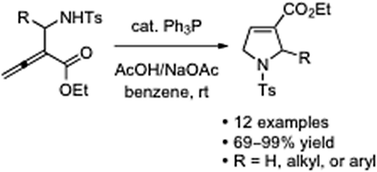
Chem. Commun., 2012,48, 5373-5375
https://doi.org/10.1039/C2CC31347B
Umpolung reactions in an ionic liquid catalyzed by electrogenerated N-heterocyclic carbenes . Synthesis of saturated esters from activated α,β-unsaturated aldehydes
The umpolung reaction of activated α,β-unsaturated aldehydes to saturated esters was obtained in an ionic liquid by organocatalysis of electrogenerated NHC.
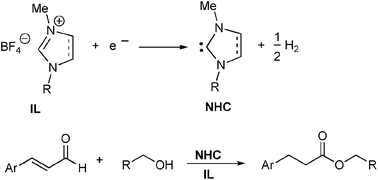
Chem. Commun., 2012,48, 5361-5363
https://doi.org/10.1039/C2CC30371J
Stereoselective amine-catalyzed carbohydrate chain elongation
A highly stereoselective organocatalyzed chain elongation of carbohydrates is described.

Chem. Commun., 2012,48, 5304-5306
https://doi.org/10.1039/C2CC31541F
Enantioselective cyclopropanation of enals by oxidative N-heterocyclic carbene catalysis
α,β-Unsaturated acyl azoliums generated by oxidative carbene catalysis react stereoselectively with sulfur ylides to give cyclopropyl carboxylic esters.

Chem. Commun., 2012,48, 5190-5192
https://doi.org/10.1039/C2CC31501G
Role of quaternary ammonium salts as new additives in the enantioselective organocatalytic β-benzylation of enals
Quaternary ammonium salts act as efficient neutral additives in organocatalyzed Michael additions to enals, promoting sequential iminium–enolate formation.
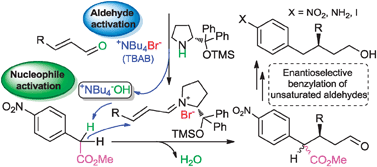
Chem. Commun., 2012,48, 5184-5186
https://doi.org/10.1039/C2CC31451G
Organocatalytic asymmetric oxy-Michael addition to a γ-hydroxy-α,β-unsaturated thioester via hemiacetal intermediates
We report an enantioselective route to β-hydroxy carboxyl compounds by asymmetric oxy-Michael addition to a γ-hydroxy-α,β-unsaturated thioester via hemiacetal intermediates.
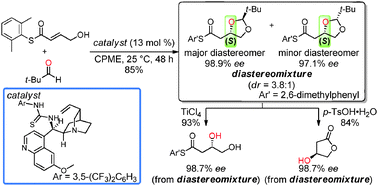
Chem. Commun., 2012,48, 5076-5078
https://doi.org/10.1039/C2CC31602A
An organocatalytic Michael-aldol cascade: formal [3+2] annulation to construct enantioenriched spirocyclic oxindole derivatives
An efficient organocatalytic Michael-aldol cascade for construction of enantioenriched spirocyclic oxindoles fused with tetrahydrothiophenes was investigated.
![Graphical abstract: An organocatalytic Michael-aldol cascade: formal [3+2] annulation to construct enantioenriched spirocyclic oxindole derivatives](/en/Image/Get?imageInfo.ImageType=GA&imageInfo.ImageIdentifier.ManuscriptID=C2CC30931A&imageInfo.ImageIdentifier.Year=2012)
Chem. Commun., 2012,48, 5160-5162
https://doi.org/10.1039/C2CC30931A
Enantioselective direct aminalization with primary carboxamides catalyzed by chiral ammonium 1,1′-binaphthyl-2,2′-disulfonates
A highly effective catalytic enantioselective direct aminal synthesis was developed. Chiral ammonium 1,1′-binaphthyl-2,2′-disulfonates, which were prepared in situ from (R)-1,1′-binaphthyl-2,2′-disulfonic acid (BINSA) and achiral amines, promoted the enantioselective addition of primary amides to aromatic aldimines.
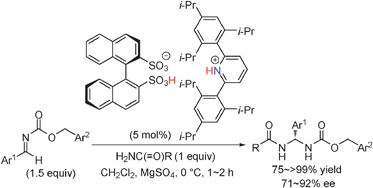
Chem. Commun., 2012,48, 4986-4988
https://doi.org/10.1039/C2CC31530K
Chiral guanidine -catalyzed asymmetric direct vinylogous Michael reaction of α,β-unsaturated γ-butyrolactams with alkylidene malonates
The asymmetric direct vinylogous reaction of α,β-unsaturated γ-butyrolactams using a C1-symmetric guanidine organocatalyst embodied a secondary amine subunit.

Chem. Commun., 2012,48, 5040-5042
https://doi.org/10.1039/C2CC31470C
A highly enantioselective approach towards 2-substituted 3-bromopyrrolidines
A facile and highly enantioselective approach towards 2-substituted 3-bromopyrrolidines has been developed.
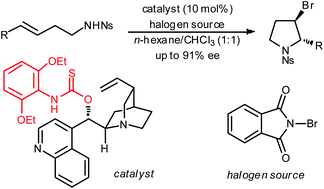
Org. Biomol. Chem., 2012,10, 3808-3811
https://doi.org/10.1039/C2OB25327E
Direct asymmetric Mannich reaction of phthalides : facile access to chiral substituted isoquinolines and isoquinolinones
Asymmetric Mannich reaction employing phthalides has been developed for the first time, which led to stereocontrolled synthesis of 3,3-disubstituted phthalides. Facile preparation of chiral isoquinolinones and isoquinolines was also demonstrated.
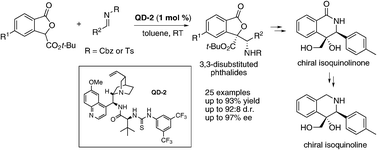
Chem. Commun., 2012,48, 4707-4709
https://doi.org/10.1039/C2CC31439H
Enantioselective synthesis of optically active cis-β-thio-α-amino acid derivatives through an organocatalytic cascade thio-Michael/ring opening process
cis-β-thio-α-amino acid derivatives through organocatalytic one pot, cascade thio-Michael/ring opening reaction were synthesized in high yields with good diastereoselectivities and enantioselectivities.
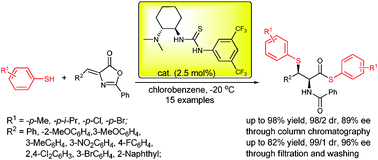
Chem. Commun., 2012,48, 4713-4715
https://doi.org/10.1039/C2CC30799E
Diarylprolinol in an asymmetric aldol reaction of an α-alkyl-α-oxo aldehyde as an electrophile
The direct aldol reaction of an α-alkyl-α-oxo aldehyde was catalyzed by trifluoromethyl-substituted diarylprolinol to afford a γ-oxo-β-hydroxy-α-substituted aldehyde in good yield with excellent anti-selectivity and excellent enantioselectivity.

Chem. Commun., 2012,48, 4570-4572
https://doi.org/10.1039/C2CC31230A
Enantioselective organocatalytic reductive amination of aliphatic ketones by benzothiazoline as hydrogen donor
The chiral phosphoric acid-catalyzed enantioselective reductive amination of aliphatic ketones with aromatic amines was successfully achieved by the use of benzothiazoline as the hydrogen donor. Corresponding chiral aliphatic amines were obtained in good yield with excellent enantioselectivities under mild reaction conditions.

Chem. Commun., 2012,48, 4573-4575
https://doi.org/10.1039/C2CC31486J
Kinetics and mechanism of organocatalytic aza-Michael additions: direct observation of enamine intermediates
Imidazole reacts with the iminium ion 2, and the failure to observe organocatalytic aza-Michael additions of imidazoles to enals is due to unfavourable proton transfer from the imidazolium fragment to the enamine unit in 3c.
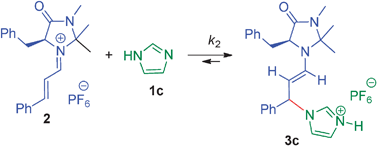
Chem. Commun., 2012,48, 4504-4506
https://doi.org/10.1039/C2CC31224G
Biomimetic catalytic enantioselective decarboxylative aldol reaction of β-ketoacids with trifluoromethyl ketones
A biomimetic organocatalytic enantioselective decarboxylative ketone aldol reaction of β-ketoacids with trifluoromethyl ketones was realized.

Chem. Commun., 2012,48, 4308-4310
https://doi.org/10.1039/C2CC30949A
Organic base-catalyzed stereodivergent synthesis of (R)- and (S)-3-amino-4,4,4-trifluorobutanoic acids
β-Trifluoromethyl-β-alanine of either (R) or (S) absolute configuration was selectively prepared using base-catalyzed reaction of (S)-N-tert-butanesulfinyl (3,3,3)-trifluoroacetaldimine with dialkyl malonates.
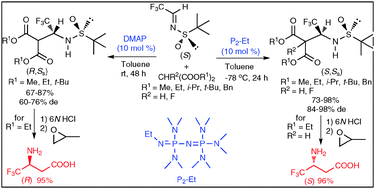
Chem. Commun., 2012,48, 4124-4126
https://doi.org/10.1039/C2CC30627A
Catalytic enantioselective synthesis of β-trifluoromethyl pyrrolines
One-pot enantioselective synthesis of β-trifluoromethylated pyrrolines was developed by the organocatalyzed-conjugated addition of nitromethane to β-trifluoromethylated enones.
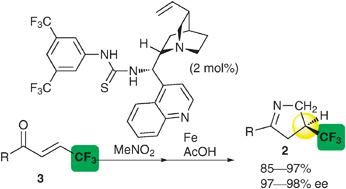
Chem. Commun., 2012,48, 4067-4069
https://doi.org/10.1039/C2CC18049A
Phase transfer catalyzed enantioselective cyclopropanation of 4-nitro-5-styrylisoxazoles
Cyclopropanes were prepared in high yields, complete diastereoselection and high enantioselectivity by reacting 4-nitro-5-styrylisoxazoles with 2-bromomalonate esters under phase-transfer catalysis.
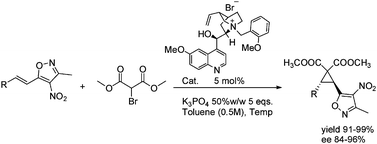
Chem. Commun., 2012,48, 3863-3865
https://doi.org/10.1039/C2CC30401E
NHC-catalysed diastereoselective synthesis of multifunctionalised piperidines via cascade reaction of enals with azalactones
NHC-catalysed highly diastereoselective synthesis of multifunctionalised piperidines from azalactones is developed.
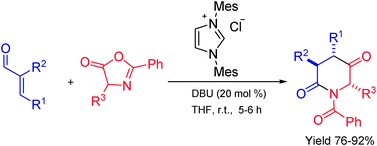
Chem. Commun., 2012,48, 3766-3768
https://doi.org/10.1039/C2CC00069E
Partially saturated fluorinated heterocycles: diastereo- and enantioselective synthesis of β-trifluoromethyl-pyrroline carboxylates
β-Trifluoromethylated pyrroline carboxylates were synthesized by organocatalytic conjugated addition of a glycine imine to β-trifluoromethylated enones, followed by a deprotection/cyclization/dehydration sequence.
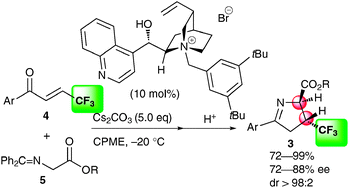
Chem. Commun., 2012,48, 3632-3634
https://doi.org/10.1039/C2CC18052A
Dioxindole in asymmetric catalytic synthesis: direct access to 3-substituted 3-hydroxy-2-oxindoles via 1,4-additions to nitroalkenes
The asymmetric Michael addition of dioxindoles (3-hydroxy-2-oxindoles, 1) to β-substituted nitroalkenes is presented. The bifunctional primary amine-thiourea catalyst A, by means of a non-covalent-based mode of activation, secures direct and easy access to valuable 3-substituted 3-hydroxyoxindole derivatives with high stereocontrol.
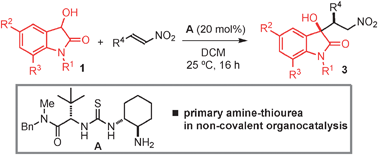
Chem. Commun., 2012,48, 3336-3338
https://doi.org/10.1039/C2CC30198A
Poly(methylhydrosiloxane)-supported chiral imidazolinones : new versatile, highly efficient and recyclable organocatalysts for stereoselective Diels–Alder cycloaddition reactions
New, recyclable PMHS-supported chiral imidazolinones promoted the Diels–Alder reaction of dienes with unsaturated aldehydes (up to 93% ee).

Chem. Commun., 2012,48, 3188-3190
https://doi.org/10.1039/C2CC17919A
Highly efficient asymmetric aldol reaction in brine using a fluorous sulfonamide organocatalyst
A fluorous organocatalyst promotes direct asymmetric aldol reactions of aromatic aldehydes with ketones in brine to afford the corresponding anti-aldol products in high yield with up to 96% ee.

Org. Biomol. Chem., 2012,10, 2209-2213
https://doi.org/10.1039/C2OB06955E
Direct amination of α-substituted nitroacetates using di-tert-butyl azodicarboxylate catalyzed by Hatakeyama's catalyst β-ICD
We report the first example of catalytic asymmetric direct amination of α-monosubstituted nitroacetates using di-tert-butyl azodicarboxylate, catalyzed by Hatakeyama's catalyst β-ICD.
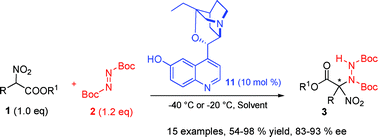
Org. Biomol. Chem., 2012,10, 1158-1161
https://doi.org/10.1039/C2OB06746C
Enantiomerically enriched trans-diols from alkenes in one pot: a multicatalyst approach
An oligopeptide equipped with catalytic moieties converts simple alkenes into enantiomerically enriched (monoprotected) 1,2-trans-diols and serves as proof-of-principle for multicatalysis.

Chem. Commun., 2012,48, 2498-2500
https://doi.org/10.1039/C2CC17435A
Enantioselective total synthesis of (+)-galbulinvia organocatalytic domino Michael–Michael–aldol condensation
Enantioselective total synthesis of (+)-galbulin via organocatalytic domino Michael–Michael–aldol condensation.

Chem. Commun., 2012,48, 2385-2387
https://doi.org/10.1039/C2CC16682H
Asymmetric oxidative Lewis base catalysis—unifying iminium and enamine organocatalysis with oxidations
Enantioselective oxidative domino reactions of allylic alcohols to functionalized esters have been developed. The domino oxidation iminium–enamine activation represents a convenient strategy for the enantioselective synthesis of differently substituted aldehydes starting from readily available allylic alcohols.

Chem. Commun., 2012,48, 2201-2203
https://doi.org/10.1039/C2CC16447G
Discovery of 2-aminobuta-1,3-enynes in asymmetric organocascade catalysis: construction of drug -like spirocyclic cyclohexanes having five to six contiguous stereocenters
We present herein for the first time the asymmetric synthesis of drug-like spiranes having five to six contiguous stereocenters through the reflexive-Michael reaction by using 2-aminobuta-1,3-enyne-catalysis under mild conditions.
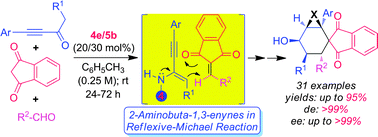
Chem. Commun., 2012,48, 2252-2254
https://doi.org/10.1039/C2CC17219D
Hexafluorobenzene : a powerful solvent for a noncovalent stereoselective organocatalytic Michael addition reaction
A dramatic enhancement of stereoselectivity has been observed when using C6F6 as an unconventional solvent in the nitro-Michael reaction of 1,3-dicarbonyl compounds catalysed by a commercially available α,α-L-diaryl prolinol. DFT calculations clarified the origin of stereoselectivity and the role of C6F6.
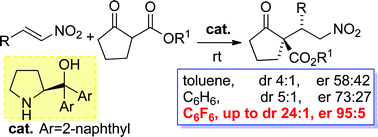
Chem. Commun., 2012,48, 1650-1652
https://doi.org/10.1039/C2CC17488J
NHC-catalyzed thioesterification of aldehydes by external redox activation
The NHC-catalyzed thioesterification of aldehydes with thiols in the presence of phenazine as a stoichiometric oxidant.
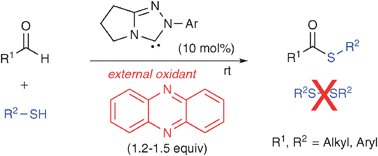
Chem. Commun., 2012,48, 1901-1903
https://doi.org/10.1039/C2CC17183J
Organocatalytic asymmetric synthesis of 3-difluoroalkyl 3-hydroxyoxindoles
We report the first example of highly enantioselective organocatalytic synthesis of 3-difluoroalkyl substituted 3-hydroxyoxindoles. The total synthesis of the difluoro analogue of convolutamydine E was achieved by this method.

Chem. Commun., 2012,48, 1919-1921
https://doi.org/10.1039/C2CC17140F
Catalytic [2+2] and [3+2] cycloaddition reactions of allenoates with cyclic ketimines
Catalytic [2+2] and [3+2] annulations of allenoates with cyclic ketimines afforded functionalized sultam-fused azetidines and dihydropyrroles in good yields with high selectivities.
![Graphical abstract: Catalytic [2+2] and [3+2] cycloaddition reactions of allenoates with cyclic ketimines](/en/Image/Get?imageInfo.ImageType=GA&imageInfo.ImageIdentifier.ManuscriptID=C2CC16055B&imageInfo.ImageIdentifier.Year=2012)
Chem. Commun., 2012,48, 1317-1319
https://doi.org/10.1039/C2CC16055B
A catalytic version of hypervalent aryl-λ3-iodane-induced Hofmann rearrangement of primary carboxamides : iodobenzene as an organocatalyst and m-chloroperbenzoic acid as a terminal oxidant
The first catalytic aryl-λ3-iodane-induced Hofmann rearrangement of primary carboxamides using iodobenzene (5 mol%) and m-CPBA was developed.
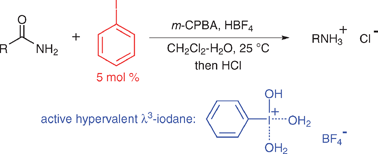
Chem. Commun., 2012,48, 982-984
https://doi.org/10.1039/C2CC16360H
Organocatalytic asymmetric tandem condensation–intramolecular rearrangement –protonation: an approach to optically active α-amino thioester derivatives
A conceptually novel chiral Brønsted base/Brønsted acid catalytic method for the enantioselective synthesis of α-amino thioesters through a tandem condensation–intramolecular rearrangement–protonation has been developed which provides a number of important synthetic building blocks in good yield and with moderate to good enantioselectivities.

Org. Biomol. Chem., 2012,10, 490-494
https://doi.org/10.1039/C1OB06623D
Design, synthesis, and application of tartaric acid derived N-spiro quaternary ammonium salts as chiral phase-transfer catalysts
A novel class of tartaric acid-derived N-spiro quaternary ammonium salts was synthesised starting from known TADDOLs. These compounds were found to catalyse the asymmetric α-alkylation of glycine Schiff bases with high enantioselectivities and in good yields.
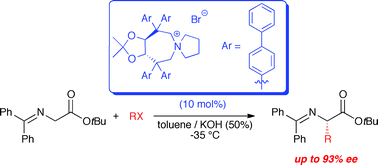
Org. Biomol. Chem., 2012,10, 251-254
https://doi.org/10.1039/C1OB06573D
Highly enantioselective Friedel–Crafts alkylation reaction catalyzed by rosin-derived tertiary amine –thiourea : synthesis of modified chromanes with anticancer potency
Synthesis and preliminary biological evaluation of various modified chromanes via a highly enantioselective Friedel–Crafts alkylation reaction is disclosed for the first time.

Chem. Commun., 2012,48, 446-448
https://doi.org/10.1039/C1CC14379D
Highly diastereoselective and enantioselective Michael addition of 5H-oxazol-4-ones to α,β-unsaturated ketones catalyzed by a new bifunctional organocatalyst with broad substrate scope and applicability
A new thiourea–tertiary amine bifunctional catalyst from L-tert-leucine provides excellent stereocontrol in a Michael addition of 5H-oxazol-4-ones to α,β-unsaturated ketones with broad substrate scope and applicability.

Chem. Commun., 2012,48, 461-463
https://doi.org/10.1039/C1CC15928C
Synthesis of 3-substituted 1,5-aldehyde estersvia an organocatalytic highly enantioselective conjugate addition of new carbonylmethyl 2-pyridinylsulfone to enals
An efficient organocatalytic enantioselective conjugate addition of new carbonylmethyl 2-pyridinylsulfone to enals has been developed for synthesis of chiral 3-substituted 1,5-aldehyde carbonyls.

Chem. Commun., 2012,48, 148-150
https://doi.org/10.1039/C1CC15714K
Chiral squaramide -catalyzed highly diastereo- and enantioselective direct Michael addition of nitroalkanes to nitroalkenes
An efficient highly diastereo- and enantioselective direct Michael addition of nitroalkanes to nitroalkenes catalyzed by chiral squaramide catalyst with a low catalyst loading (2 mol%) afforded synthetically useful 1,3-dinitro compounds in high yields with high diastereoselectivities (up to 95 : 5 dr) and excellent enantioselectivities (up to 97% ee).
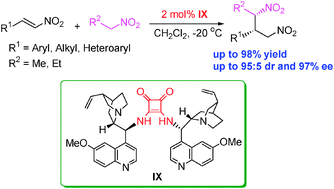
Chem. Commun., 2011,47, 12706-12708
https://doi.org/10.1039/C1CC15946A
Graphene oxide: an efficient and reusable carbocatalyst for aza-Michael addition of amines to activated alkenes
Graphene oxide is reported as a highly efficient and cost-effective organocatalyst for the aza-Michael addition of amines to activated alkenes.
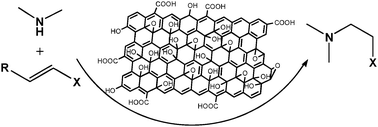
Chem. Commun., 2011,47, 12673-12675
https://doi.org/10.1039/C1CC15230K
Organocatalytic enantioselective (3+2) cycloaddition using stable azomethine ylides
The use of stable isoquinolinium and phthalizinium methylides in the organocatalytic enantioselective (3+2) cycloaddition with enals is presented.
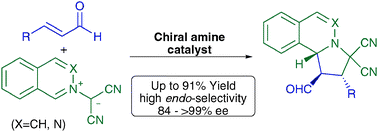
Chem. Commun., 2011,47, 12313-12315
https://doi.org/10.1039/C1CC15671C
Transforming terpene -derived aldehydes into 1,2-epoxides via asymmetric α-chlorination: subsequent epoxide opening with carbon nucleophiles
Merging Jørgensen's and MacMillan's organocatalytic aldehyde chlorinations enables the synthesis of chiral vinylcyclopropanes and (−)-cis-aerangis lactone via terpene-derived 1,2-epoxides.
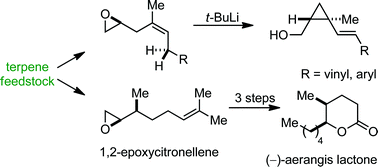
Chem. Commun., 2011,47, 12200-12202
https://doi.org/10.1039/C1CC15173H
Brønsted acid-catalyzed enantioselective Friedländer condensations: achiral amine promoter plays crucial role in the stereocontrol
A highly enantioselective Friedländer condensation has been established by using chiral Brønsted acids in combination with achiral amines to give quinolines in high yields (up to 99%) and with excellent enantioselectivities (up to 95%).

Chem. Commun., 2011,47, 11683-11685
https://doi.org/10.1039/C1CC14873G
New synthesis of spirocycles by utilizing in situ forming hypervalent iodine species
An effective spirocyclization procedure for installing nucleophiles via iodonium(III) salts has been developed using the combination of bis(iodoarene) and mCPBA.
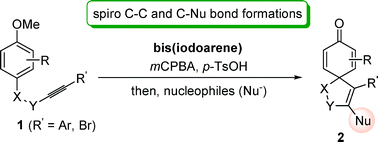
Org. Biomol. Chem., 2011,9, 6899-6902
https://doi.org/10.1039/C1OB06199B
syn-Selective asymmetric cross-aldol reactions between aldehydes and glyoxylic acid derivatives catalyzed by an axially chiral amino sulfonamide
syn-Selective asymmetric cross-aldol reactions of aldehydes with tert-butyl glyoxylate and glyoxamide 2 were realized by the use of an axially chiral amino sulfonamide (S)-1. The cross-aldol products are readily converted to useful chiral building blocks such as γ-lactone and γ-lactam.

Chem. Commun., 2011,47, 10626-10628
https://doi.org/10.1039/C1CC14347F
Diastereo- and enantioselective conjugate addition of α-substituted nitroacetates to maleimides under base-free neutral phase-transfer conditions
Highly diastereo- and enantioselective conjugate addition of α-substituted nitroacetates to maleimides under base-free neutral phase-transfer conditions was developed.
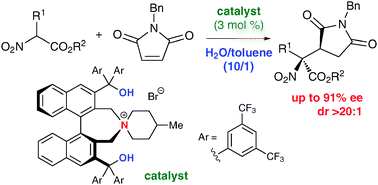
Chem. Commun., 2011,47, 10557-10559
https://doi.org/10.1039/C1CC14043D
Highly enantioselective synthesis of Warfarin and its analogs catalysed by primary amine –phosphinamide bifunctional catalysts
An efficient enantioselective Michael addition of 4-hydroxycoumarin to α,β-unsaturated ketones catalysed by primary amine–phosphinamide bifunctional catalysts afforded Warfarin and its analogs in moderate to excellent yields (up to 99%) and good to excellent enantioselectivities (up to 99% ee).

Org. Biomol. Chem., 2012,10, 8125-8131
https://doi.org/10.1039/C2OB26334C
Squaramide-catalysed enantio- and diastereoselective sulfa-Michael addition of thioacetic acid to α,β-disubstituted nitroalkenes
A highly enantio- and diastereoselective sulfa-Michael addition of thioacetic acid to α,β-disubstituted nitroalkenes catalysed by a chiral squaramide organocatalyst (0.2 mol%) afforded β-nitro sulfides in excellent yields with good diastereoselectivities and high enantioselectivities (up to 94 : 6 dr, 95% ee). This catalytic reaction can be performed on a 10 gram scale.

Org. Biomol. Chem., 2012,10, 6876-6884
https://doi.org/10.1039/C2OB26068A
Carbonate, acetate and phenolate phosphonium salts as catalysts in transesterification reactions for the synthesis of non-symmetric dialkyl carbonates
Carbonate, acetate and phenolate phosphonium salts are excellent organocatalysts for the transesterification of dimethyl and diethyl carbonate with primary and secondary alcohols, including benzyl alcohol, cyclopentanol, cyclohexanol, and the rather sterically hindered menthol.

Org. Biomol. Chem., 2012,10, 6569-6578
https://doi.org/10.1039/C2OB25447F
Enantioselective synthesis of gabapentin analogues via organocatalytic asymmetric Michael addition of α-branched aldehydes to β-nitroacrylates
Michael addition of α-branched aldehydes to β-nitroacrylates was successfully carried out by using a mixed catalyst consisting of a primary amino acid, L-phenylalanine, and its lithium salt to give β-formyl-β′-nitroesters having a quaternary carbon centre in good yields with high enantioselectivity.
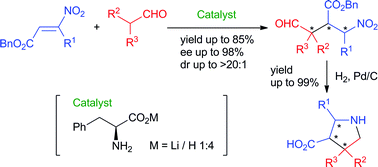
Org. Biomol. Chem., 2012,10, 5289-5297
https://doi.org/10.1039/C2OB25413A
Direct catalytic asymmetric synthesis of highly functionalized (2-ethynylphenyl)alcohols via Barbas–List aldol reaction : scope and synthetic applications
A general approach to high-yielding asymmetric synthesis of (2-ethynylphenyl)alcohols as synthons in medicinal chemistry was achieved through Barbas–List aldol reaction on ketones with 2-alkynylbenzaldehydes in the presence of a catalytic amount of trans-4-OH-L-proline or L-prolinamide derivative.
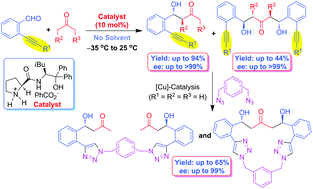
Org. Biomol. Chem., 2012,10, 5094-5101
https://doi.org/10.1039/C2OB25563D
A tripeptide-like prolinamide-thiourea as an aldol reaction catalyst
A tripeptide-like prolinamide-thiourea catalyst with (S)-proline, (1S,2S)-diphenylethylenediamine and (S)-di-tert-butyl aspartate as building blocks provides the products of the reaction between ketones and aromatic aldehydes in high to quantitative yields and high stereoselectivities (up to 99 : 1 dr and 99% ee).
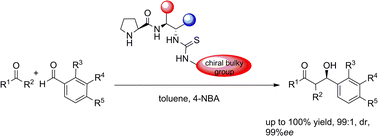
Org. Biomol. Chem., 2012,10, 5613-5619
https://doi.org/10.1039/C2OB25693B
Synthesis and evaluation of atropos dihydro-5H-dibenzazepinium halide PTCs derived from α-methylbenzylamine
A short synthetic route to diastereoisomeric atropos dihydro-5H-dibenz[c,e]azepinium salts via reaction of a single enantiomer of (R)-α-methylbenzylamine with a racemic atropos biphenol derivative is described.
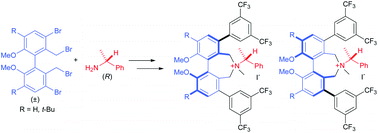
Org. Biomol. Chem., 2012,10, 4968-4976
https://doi.org/10.1039/C2OB25437A
Polystyrene-supported TBD catalyzed ring-opening of N-tosylaziridines with silylated nucleophiles
Polystyrene-supported TBD (PS-TBD) catalyzes the ring-opening of N-tosylaziridines with silylated nucleophiles to give the corresponding products in high yields. PS-TBD was easily recovered and reused without significant loss of catalytic activity.
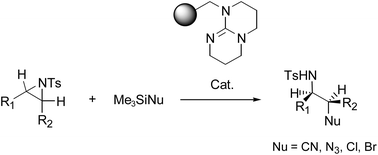
Org. Biomol. Chem., 2012,10, 4886-4890
https://doi.org/10.1039/C2OB25435B
About this collection
The peer-reviewed articles in this joint ChemComm-OBC web themed issue highlight recent cutting-edge achievements in the exciting field of organocatalysis.
The guest editors of this issue are Keiji Maruoka (Kyoto University), Hisashi Yamamoto (University of Chicago), Liu-Zhu Gong (University of Science and Technology of China) and Benjamin List (Max-Planck-Institut für Kohlenforschung).
Articles in this web themed issue will be added to the list below as soon as possible, after they are published. Please return to this page frequently to see this collection grow.
For information about submitting to this issue, please see the ChemComm blog.